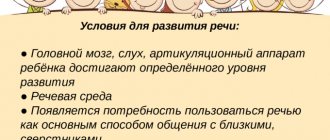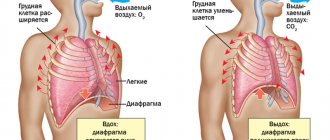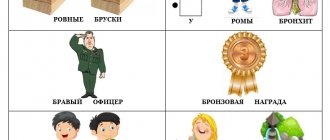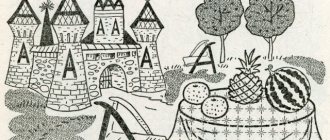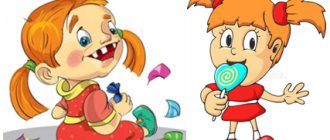Causes of impaired pronunciation of the sound Ш
If the child is healthy and does not have problems with hearing and intellectual development, then the following factors may be the reasons for the distortion of the pronunciation of the sound Ш:
- Defective speech breathing. The child speaks quietly, is often interrupted, and the end of sentences is chewed due to lack of air in the lungs. Sound pronunciation is distorted due to difficulty breathing when speaking. The problem can be identified by the fact that, while talking, the patient exhales air through the nose sharply, noisily, and also takes in short breaths halfway through the sentence. If you have this problem, you can practice at home. With daily exercises lasting about 5 minutes, positive results can be achieved within a month.
- Defective speech hearing. In this case, the patient does not distinguish words that sound similar. Moreover, he believes that he speaks correctly, the way the people around him speak. Due to impaired phonemic hearing, difficulties arise while studying at school. Reading and writing are difficult for schoolchildren, and dyslexia often develops. The development of phonemic hearing begins at the stage of intrauterine development, so pregnant women are recommended to talk with the fetus in the stomach. Hearing development is completed by the age of 4, and if a child by this age still distorts spoken sounds, then he should be taken to a pediatrician and speech therapist.
- Weakness of the articulatory apparatus. The clarity of sound pronunciation is determined by the level of functionality of the articulatory system and the quality of work of the oral organs. With a defective location and weakness of the organs of the oral cavity, the pronunciation of sounds is distorted. We are talking about an abnormal bite, abnormal structure of the palate, crooked teeth growth. All these are factors leading to dysarthria. To normalize pronunciation, the development of linguistic and facial muscles is required.
- Abnormal structure of the frenulum. Each person has an individual length of the frenulum - the webbed strip of tissue under the tongue. But a child may experience speech impediments if the frenulum is too short, causing the tongue to not reach the roof of the mouth or extend out of the mouth to a sufficient length. In young children, the problem manifests itself as a violation of the sucking function, in older children - the formation of an abnormal bite. Correction of the problem is first surgical (trimming in a dental clinic), then speech therapy. Typically, small patients whose frenulum is so short that the tongue can hardly lift up are sent for surgery. If the problem is not so serious, then speech therapy sessions to develop the hypoglossal ligament are sufficient.
Reasons for the absence of the correct "Sh"
If we are talking about a healthy child with normal hearing and intact intelligence, the following reasons for distorted sound pronunciation are identified:
- Incorrect speech breathing. If there are breathing problems, the child’s speech remains quiet, he stumbles over every word, and the end of the sentence is swallowed due to lack of air. The same process is observed in sound pronunciation; many sounds are distorted due to difficulty in speech breathing. You can notice difficulties when the exit during a conversation is sharp, through the nose. The child can also take small breaths to finish the sentence. You can practice at home. With daily practice that lasts no more than five minutes, the results will appear within a month, which will significantly speed up the process of sound production.
- The problem is speech hearing. Thanks to phonemic hearing, it becomes possible to distinguish consonant words. A deviation occurs when a child does not notice differences in his pronunciation from other people. Impaired speech hearing leads to difficulties in learning to write and read. In some cases, dyslexia develops. The formation of speech hearing should be addressed from the moment of pregnancy, when auditory receptors begin to form in the fetus. Phonemic hearing develops by the age of four, so if after this age the child still pronounces sounds incorrectly or does not agree on the endings in words, this is a reason to contact a specialist. A comprehensive examination and medical history will help to more accurately determine the direction of correcting the disorder.
- Poor development of the articulatory apparatus. The quality of sound pronunciation depends on the functioning of the speech apparatus and the individual work of the organs of the oral cavity. Sounds are formed in the oral cavity, so the correct location of the organs that are responsible for speech plays an important role in sound pronunciation. Incorrect structure may include an incorrect bite, the structure of the palate, or the formation of teeth. All this leads to the formation of blurred speech, unclear pronunciation of words and sounds. For accurate sound pronunciation, it is necessary to develop motor activity of the tongue, lip mobility (smile, rounding), and fixity of the lower jaw.
- Individual structure of the frenulum. All people have different lengths of the hyoid frenulum. Problems with the correct production of sounds may arise if parents notice that the child does not reach the upper palate with his tongue, the tip of the tongue does not protrude, and the child cannot make a clicking sound. A short frenulum prevents the sucking reflex and creates an incorrect bite. You can correct the problem with the help of a speech therapist or dentist. Surgery to trim the frenulum is required for children who exhibit a lump or attachment to the actual tip of the tongue. In cases where structural problems have not been identified, they suggest developing the ligament with special exercises and massage. Usually, problems are identified during examinations of newborns, who can have their frenulum cut immediately in the maternity hospital.
Staging the sound Ш step by step
When pronouncing each sound, parts of the articulation apparatus take a certain position. If the organs of articulation are placed incorrectly at the time of pronunciation, then a distorted sound is obtained.
The articulation of the sound Ш is correct when the speech organs are located as follows:
- The lips are slightly pushed forward, folded in the shape of an open pipe.
- The tip of the tongue rises to the palate, but does not rest against it. There should be a gap left.
- The tongue is cupped and pressed against the inner sides of the upper teeth with its lateral edges.
- The vocal cords remain relaxed. The air stream comes out of the mouth freely.
Exercises are carried out both with a speech therapist and at home. But parents learning how to make the sound Ш for their child at home need to take into account that classes should be regular. This is the only way to achieve a quick positive result.
Lesson 6
Exercise for developing a long exhalation “The wind is noisy.” Place the bottle upside down at nose level. Raise your wide tongue to your upper lip and blow strongly on your tongue. Noise is heard in the bubble. "The baby elephant drinks some water." Make a “proboscis”. Inhale and exhale air through your mouth. Lip exercises Repetition of exercises from previous classes. Development of coordinated movements of the lips and tongue. Extend the lips into a “tube” and the tongue into a “cup” (outside the mouth). Exercises for the tongue Repetition of exercises from previous lessons. "Harmonic". Smile, open your mouth slightly. Glue your tongue to the roof of your mouth, then, without lowering your tongue, close and open your mouth. As you repeat the exercise, open your mouth wider and hold your tongue longer. Development of switchability of the organs of the articulatory apparatus and development of coordinated work of the lips and tongue. Hippo Booby learns to pronounce the syllables bdi-bdi-bdi, bdi-bde, bdya-bde, bde-bdya-bdi. Development of phonemic perception Selecting pictures whose names contain the sound [w] from other pictures whose names contain [s] and [z]. The teacher pronounces the words, and the child chooses pictures whose names contain the sound [w]. Producing the sound [sh] The position of the organs of the articulatory apparatus when pronouncing the sound correctly [sh] The lips are slightly rounded and stretched forward in a “tube”. The teeth are brought together at a distance of 1-2 mm. The tip of the tongue is raised in a “cup”, but does not touch the palate. The lateral edges of the tongue are pressed against the upper molars, and the middle of the front of the tongue forms a semilunar fissure with the palate just behind the alveoli. The soft palate is raised, the vocal cords are open. The exhaled air stream is strong. If you put the back of your hand to your mouth, you feel warmth. Techniques for producing sound [w] Auditory perception of sound. Creating an auditory image of the sound “Noisemakers”. Onomatopoeia The sound of the wind in the forest; the rustle of leaves on the trees; rustling of dry leaves; rustling of dry hay or straw, paper; the hiss of a gander, a snake; the rustling of mice in a hole, tires on the pavement; the sound of air escaping from a punctured balloon, a locomotive releasing steam. Formation of a visual image of the sound [w] Showing the articulatory profile. Clarification of the position of the lips, teeth and tongue. Description of the position of the organs of articulation. Forming a sense of the position of the organs of articulation with the help of toys. Look how the monkey lifts its tongue “cupped” by its upper teeth. Demonstration of correct articulation of the sound [sh]. Draw the child's attention to the position of the lips, teeth and tongue. Plastic representation of the shape of the tongue with the hands. With your right hand, depict the shape of the tongue as a “cup”, and with your left hand, the palate. Setting the sound [w] according to R.I. Levina (1965) Setting the sound [w] by imitation Raise the tongue to the upper lip and exhale air evenly, forcefully, controlling the air stream with the back of the hand. Having achieved the release of a warm stream of air from the position of the tongue at the upper lip, move the tongue over the upper teeth to the palate with the mouth open. Round your lips and stretch them forward, bring your teeth together at a distance of 1-2 mm and exhale. The sound should be [w]. Setting the sound [w] based on the sound [t] Pronounce the sound [t] several times at intervals of 2-3 seconds. Then the setting is given: the tongue “knocks” not on the teeth, but on the tubercles (alveoli). The sound [t] is pronounced at first with an aspiration, while a weak and short hissing sound is mixed with the sound of the explosion. Round your lips and extend them forward, raise your tongue to the front of the palate. Press the lateral edges of the tongue against the molars. Transition from the sound [t] to the sound [w]: t-t-tshshsh. Subsequently, the noise lengthens and is freed from the previous sound [t]. Setting the sound [w] on the basis of the sound [r] Pronounce the drawn-out sound [r] without a voice or in a whisper, gradually reducing the force of exhalation until the vibration stops and a faint hiss appears. With repeated exercises, the sound [w] is obtained without the previous pronunciation of a dull sound [r]. Hissing can be obtained by touching the lower surface of the tongue with a spatula, slowing down the vibration of the tongue. Setting the sound [w] on the basis of the sound [s] Place the tongue behind the lower teeth. Invite the child to pronounce the sound [s]. At the same time, use a spatula or probe to lift the tongue upward. Using the fingers of your right hand, lightly press on your cheeks and push your lips forward. Instead of a whistle, you should get a hiss. You can invite the child to repeat the syllables sa, so, sy, asa, asy, as, os while simultaneously lifting the tongue with a probe or spatula. Setting the sound [w] on the basis of the sound [h] Pronounce the sound [h] followed by a long exhalation. You should feel a warm stream of air on your hand brought to your mouth.
Articulatory gymnastics for producing the sound Ш
The first and mandatory stage of a speech therapy session is articulation gymnastics. It is necessary to restore tone to the muscles of the speech apparatus.
Articulation gymnastics for the sound Ш may include the following exercises:
- "Hippopotamus". The patient opens his mouth wide for 5 seconds, then closes it.
- "Little Frog." You need to smile widely, leaving your teeth closed.
- "Tube". The child stretches out his lips with a pipe and holds it for several seconds.
- "Yummy". You need to relax your tongue so that it takes a flat shape and lick your upper lip with it.
- "Pancake." A flat, relaxed tongue should be placed on the lower lip for a few seconds.
- "Drawing". The child moves the tip of his tongue, like a brush, across the palate from the teeth to the uvula.
Word combinations and phrases starting with the sound Ш
Phrases starting with the sound Ш at the beginning and at the end of words in monosyllabic words.
Step quietly, Misha's check, the shawl is being sewn, the ball is hissing, Shura's chance, the scarf is wide, the seam is rough, silk is being sewn, the noise of mice, the jester is making noise, Misha's thorn, sewing a scarf, the boss is making noise, a shaky pole, six mice, mouse hair, mouse lice , nimble ruff, bumblebee shushes, helmet spire, Misha's helmet, airlock hose, Misha's headquarters, ball stamp, headquarters staff, shaky closet, stroke writes, noisy mouse, your boss, Mishin's shower, our ruff, Machine ink, rough penny, pants flare, bear plush, Mishkin minced meat, Masha eat, Misha smear, give me a helmet, you are carrying a knife, the hedgehog is rustling, already hissing, the siskin is making noise, you are carrying the cake, sixth floor, your guard, the swift is rustling, brother-in-law’s scarf, eat porridge, the seamstress is sewing, I’m sewing an overcoat, it’s in the way of sewing, I’m decorating a brooch, I’m embroidering a shawl, the sound of footsteps, a wide scarf, I’m walking, a noisy hedgehog, a darned shawl, give me a basket.
Phrases starting with the sound Ш at the beginning, in the middle of a word in 2 complex words with an open syllable.
Noisy highway, Car fur coat, Shunya hissing, Shura making noise, awl sewing, tire rustling, sperm whale neck, Misha eat, Masha Shay, Pasha walk, Lusha Shay, Quiet noise, Dasha write, Sasha darn, your porridge, bowl of porridge, your Masha , our Dasha, I write jokes, I breathe with my soul, I wear an awl, I wave to Masha, I dance shakily, my ears listen, Dasha is a cat lover, chiffon ruffles, grandmother’s fur coat, millet porridge, Tosha’s fur coat.
Phrases with the sound Ш at the beginning, in the middle of a word in 3 complex words with an open syllable.
The tent is noisy, the charade is noisy, the width of the scarf, the latitude of latitudes, the husk rustles, Katyusha writes, Alyosha strides, Natasha rustles, Vanyusha shushes, Timosha staggers, the poster rustles, the young man jokes, Mashina's galoshes, Dashina's gaiters, Misha's hoarders, cutie Dasha, ruff scales , the tinsel rustles, the sieve is cheap, the riffraff whispered, broke the silence, the width of the parachute, the school charade, the reeds sway, the mother frog, walk wide.
Collocations with the sound Ш at the beginning, in the middle of a word in 2 complex words with an open syllable, with a confluence in the middle of the word, at the beginning of the word.
The mongrel is noisy, Shura's puck, woolen hat, shaky mine, Misha's checker, Shura's shorts, mouse fur, Masha's fur coat, Misha's joke, Masha's shurpa, silk screen, seamstress's sewing, rough cone, sewing awl, very noisy, patronage of the headquarters, ear hears , Mishuta's cannon, tower spire, cherry Machine, mousetrap cat, midge is in the way, wide tower, suede is sewn, eat noodles, left-hander waves, eat haddock, haddock scales, gang of devils, Shawka's collar, connecting rod bear, writing jokes, eat cherries, gang sharpers, silk muffler, connecting rod bear, taller than the tower.
Phrases with the sound Ш at the beginning, in the middle, at the end of a word in 2 complex words with a closed syllable.
The naughty man is walking, a bag of chestnuts, the driver of the Skoda, the sharpie was fumbling, the hut is good, he found a lily of the valley, a wide screw, a bag of sage, fooling the riffraff, the baby's prank, the wide slate, the donkey was staggering, the chestnut is making noise, the horse is plowing, The ball is naughty, the baby's step, walking at a pace, the jackal is naughty, the ball hisses, the hut is staggering, the naughty baby, the shaman is dancing, the brown-haired man is joking, the tent is shaky, the crankshaft bear is shaking, the pole is shaking, the kids are pranking, the driver is in a hurry, the rustle of mice, the whisper of a baby, the screw is staggering, Pasha’s overcoat, the hissing goose , shush the cat, shaky slate, chiffon is sewn, masterpiece strudel, rustle of chiffon, donkey shushes, tub tub, fur coat sash, hang a fur coat, breathe noisily, eat shurpa, horse walks, stir shurpa, baby’s bruise, belyash Dashin, interfere with goulash, reeds makes noise, the lavash is thin, the baby is naked, the white bread crumb, the driver's finish, eat the white bread, give the reeds, walk noisily, see the tower, buy a tub, save shillings, the driver's garage, the doorman's luggage, the Chapiteau arena, the baby's playpen, a spinach replica, Dasha's massage .
Phrases starting with the sound Ш at the beginning, in the middle of a word in 2 complex words with a combination of consonants in the middle with a closed syllable.
Fur coat pattern, shaman sage, mine miner, haddock skewer, wool scarf, shaky hut, step wide, cherry shampoo, shuffle galoshes, shush mice, sixth joker, wide deck chair, noisy hornet, marshal shushed, rustle, listen to silence, hear noise, mix sage, a pot of porridge, a jug of reeds, a kite is noisy, a ladle of ruffs, a wide heath, the luxury of silk, a silly bear, a strong Misha, a curly baby, a lily of the valley rustles, a mole rat, a black sheep, petting a cat, you know Sweden, writing jokes, drainage of lilies of the valley , wasteland landscape, payment of a fine, headquarters watchman, spy's drawing, the rack is shaky, the miner made noise, the marshal is marching, the saddler approached.
Phrases starting with the sound Ш at the beginning, in the middle of words, in 3 complex words with an open syllable with a combination of consonants at the beginning, in the middle of the word.
Hat Shapoklyak, the chess is noisy, the checker player Masha, the sixth fur coat, Dasha's skimmer, the joker Dasha, Mishutka's joke, the hissing of the cat, the hissing cat, the fizz hissing, the rough cone, the chinchilla is noisy, the wide couch, the rough brochure, Misha's machine, mouse embroidery, cat patch , fluff Chinchilla, wide dryer, stew stew, wheat rustles, tower higher, chocolate cherry, darling little pillow, cat hisses, toy cannon, millet donut, wide cup, funny scarecrow, cat bug, funny frog, Anushka the nimble, Andryusha the nimble, grandma noisy, playful grandfather, silk pillow, top of bear's head, reel of silk, rough dumpling, noisy cuckoo, Misha's tub, edge of the noisy, shell is noisy, top of the tower, grandfather's chess, eating stew, Pasha's shirt, good shoes, scammer's mistake, baby monkey, insects are rustling, Alyosha's shirt, the frog-croak.
Phrases starting with the sound Ш at the beginning, in the middle of a word in 3 complex words with a closed syllable.
Misha's pedometer, sewn hut, shaman Shura, noisy shaman, fur coat fluff, thorn cutter, fizzy cider, hissing sound, wide scarf, cherry chocolate, move the hut, peel the husk, funny donkey, walk upstairs, sickening ammonia, irrigate the edge, drain the tub , console grandma, noisy cockerel, silk hood, sixth spine, effervescent powder, wide strap, wide burdock, little naughty boy, cheap hut, bag of cones, nimble mouse, writing grandfather, make a funny joke, make noise with a slotted spoon, embroidered hood, mouse noise, drain edge, echelon of cones, mad sperm whale, Misha the cook, fluffy cashmere, silk wallet, leisurely pedestrian, good hut, stir up cones, dry cones, finish drying cones, finish stewing champignons, dry champignons, alter a fur coat, effervescent snake, good charlatan, found a pebble, an abandoned wallet, a funny mess, a hissing little gosling, a funny duckling, a hissing little gosling, a funny cub, a noisy carriage.
Complex phrases with the sound Ш.
Sews pants, wide trousers, a good crib sheet, a shaky wardrobe, a chimpanzee whispers, a wide-brimmed hat, a hissing cat, a choking cough, a reckless young lady, Glasha the manicurist, shuffling steps, chocolate charlotte, writing with a pencil, a school teacher, a walking path, noisy birds, chopping a pear , Alyonushka's brooch, chinchilla fur coat, stewed champignons, chic chignon, good-natured horse, plopped a nut, silk curtain, grandfather's spoon, wear a fur coat, scaly helmet, reed cuckoo.
3 word sentences.
Pants for Yasha. Scarf seam. Rough seam of the shawl. They sew a shawl for Shura. Champignons on skewers. Yasha has a bag. Neck and ears. I sewed on a machine. Peas on the palm. The baby has a pencil. Cartoon of a chess player. Scots from Scotland. Grandfather and grandmother. The driver has checkers. Found it in a bag. Lump on top of head. There are coils in the box. Mug with lid. Marisha in a hairpiece. The baby is wearing a shirt. A book about a mouse. The rustling of car tires. Cat in a basket. Lattice on the tower. Champignons in a basket. Seam on a fur coat. Galoshes and gaiters. Beshmets and hoods. There are crumbs in the hole. There was an awl in the tire. There is a sash on the shirt. I walk in boots. Boy and girl. There's a fish in the ladle. Found in the closet. The bear has a bump. On grandma's neck. Chinchilla fur coat. It wobbles on its hinges. There is a bug on the chamomile. There are polka dots on the palm. Frog on the pillow. The jester behind the screen. There is slate on the roof. Charlatan with a barrel organ. Feels good. Playing pranks at school. Rustle in silence. Bumblebee and hornet. Pies with cottage cheese. Flags and balls. Sniffle and cough. A stain on a shirt. Chamomiles on arable land. Hat in the closet. Fur coat on a hanger. There is a cheesecake under the pillow. There is silence in the hut. Our hut is good. Do you want kebab? The hat maker sews hats. Masha, eat some porridge. Misha eat chocolate. Boy, why are you silent? Grandma is embroidering a cockerel. Shock is our way of speaking! Masha eats stew. The shushera whispers noisily. The miner was destroying the mine. The baby's mother is brown-haired. I hurt my neck. Natasha writes in ink. The jackal's steps are silent. The horse walked at a walk. A tractor driver plows the arable land. Misha writes well. Checker under the couch. Box in the closet.
4 word sentences.
Left our school. Our Masha is taller than yours. Checkers and chess. The cat hisses on the pillow. Alyosha has a wide flatbread. The mouse rustles under the overcoat. Grandfather and grandmother are nearby. Kids play tag. Dasha is embroidering a pillow for her grandmother. A schoolboy is making noise outside the school. The baby has a rustling rattle. Yasha has millet porridge. Grandma sews pants for Yasha. Yasha has a bag of chestnuts. Shahina walked in high heels. I embroider a shawl with silk. Pasha was wandering around the school. The navigator walked to the helm. I give the box to the young lady. You take, rub and give. I moor the boat well. The marshal left noisily. I went to the garage[w]. The matryoshka fell off the barrel organ. I have a big closet. I have good shoes. Our mice are quieter than yours. The saddler approached the hut. The wallet contains a meter of silk. The brooch adorned my grandmother's neck. Sprouted potatoes in a bag. The cracklings hissed on the stove. The work wasn't going well. They gave Dashutka a nice fur coat. The quieter you go, the further you'll get. The sooner you start, the sooner you get there. Know more, talk less. Stretch the knives across the clothes. When you speak, think carefully. When you eat, chew well. Talk less, do more. You can't heat the sea with an awl. According to Ivashka and the shirt. Misha lost two pawns. A naughty cat rolls a ball. There is a small house at the edge of the forest. Wide shoe under the cabinet. Gorgeous lily of the valley by the path. The cuckoo rustles at the edge of the forest.
5 word sentences.
Please do not destroy the car noisily. Misha has a stain on his shirt. Arisha has champignons in her basket. A seamstress sews on a sewing machine. Masha found twine in the bag. Shrek is wearing a chiffon scarf. Grandmother sewed a hat from chinchilla. The cat has a neck and ears. Grandfather shuffled towards Katyusha. The sheikh was served sherbet and sheptal. You can't hide an awl in a bag. They put on Pasha's galoshes and gaiters. The little bug darted into the basket. I am writing a petition about the miners. Naked babies spank in flip flops. Barrels mumble and shawls shuffle. The shuffling of feet did not disturb the silence. Natasha came in, rustling her silk shawl. You're being naughty again, my baby. Grandma's box was found in the closet. In the hut only the bumblebee made noise. A mind is good, but two is better. A horse is a gift, and a spoon is a gift. At the feast the beaters are dancing. Masha is good, but not ours. You are welcome to our hut. Aunt Dasha is sewing a shirt for me. Grisha has a book under his arm.
Sentences of 6 or more words.
A cat and a mouse are embroidered on the pillow. I sew shorts on a sewing machine. I wear a fur coat and a hat with earflaps. Baby Masha has a warm hat and scarf. Chiffon ruffles and wide embroidery were sewn onto the dress. I write jokes for Dashutka and Mishutka. The wind rustles over the roof and the reeds sway. How quiet - only the wind moves the reeds. The hat shop sewed hats, beshmets and hoods. A storm squall threw the boat onto the skerries. A young lady entered in a dressing gown decorated with vents and a train. We watched as the Schwab and Spree schooners moored. Car tires rustled next to the footpath. The little mouse has crumbs in his hole. Pies with potatoes are good for the road. A boy and a girl from our school emerged winners of the checkers and chess tournament. The silence of the sweltering afternoon was broken by the steps of Brother-in-law's grandfather. A good team has a horse in its body. Not nice in a good way, but nice in a nice way. The cat is only good for mice. An inept seamstress and a needle and thread get in the way of sewing. We’ll eat and dance, but we won’t invade the arable land. If you lose something, you will gain it again; if you lose a friend, you will never get it back. With a good friend you will move mountains, with a bad friend you will experience grief. You'll walk away from a drop, but you'll end up in the rain. You can't clap with one hand. In the cold the cat does not catch mice. Misha and Pasha are playing checkers. Alyosha and grandfather went to collect pine cones. Masha went out to the edge of the forest and saw a cuckoo. I walked along the bank and found a white pebble. A mouse rustles in a hole, and a cat is guarding it. The kids in our house love to read books. Grandma and Alyonushka went for a walk to pick up some nuts. It’s good to walk along the edge of the forest in the morning. Two jumping frogs made noise at the edge of the forest. I found a bug on a large daisy. Masha rested at the edge of the forest and moved on. Natasha found a lily of the valley, and I found three lilies of the valley. As soon as you approach the shore, you will see a small hut. On the palm is a tower, a tiny tower, a toy tower painted white.
The article was prepared and compiled by Speech therapist Irina Petrovna. You can contact me about alalia correction classes via Skype.
Mimic gymnastics
This is a special part of articulatory gymnastics for the sound Ш, toning the facial muscles, preparing them for work.
Mimic gymnastics consists of a set of exercises:
- Move your lips left and right. 5 times in one direction and the other. After a short pause, repeat 4 more times.
- Inflating now the right, now the left cheek. Repeats 5 times with short pauses.
- Wrinkling the eyebrows and puffing out the cheeks to create an angry expression. Repeat 4 – 5 times.
- Raising the eyebrows to create a surprised face. Repeat 4 – 5 times.
- Alternating frequent blinking and slow opening and closing of the eyes.
- Image of any funny faces.
To make it more interesting for your child to study, you can use rhymes and stories to accompany the exercises. This will have double benefits - the development of facial expressions and memory training.
Breathing exercises
Performed after articulation gymnastics. The following game-based speech therapy exercises are recommended for establishing the sound Ш:
- "Football". The speech therapist places a cotton ball on a horizontal surface and invites the patient to score a goal into an improvised goal with a stream of air. But the cheeks cannot be inflated; the air is blown out only with the participation of the lips folded into a pipe. It is advisable for the speech therapist to hold the child’s cheeks with his palms during the exercise. The exhalation should be such that a solid, even air flow comes from the mouth.
- "Butterfly" on a flower. A butterfly and a flower are cut out of colored cardboard and connected. The speech therapist asks the patient to blow the butterfly off the flower in a manner similar to the above.
Exercises for producing Ш from the sounds T, S, R and vowels
Methods such as placing the sound Ш are common in speech therapy practice and give quick positive results. They are carried out as follows:
- From sound C. This setting option is used when the patient has no defects in the functionality of the speech apparatus. The child raises his tongue to the sky, pronounces S in a relaxed manner. Then he releases air, continuing to pronounce. A hissing sound comes out. The air stream should flow without tension in the facial muscles or distortion of facial expressions. This exercise helps the child understand how whistling sounds differ from hissing sounds. Often, children have a problem with the sound Ш due to a mixture of the upper sibilant with the lower sibilant.
- From the sound T. This method of correction is used when a child is diagnosed with interdental sigmatism. At the first stage, the patient learns to touch the upper teeth with the tip of his tongue, pushing it out slightly. This is how the T sound is practiced. Next, the soft form of T is pronounced several times at a slow pace. When pronouncing, the exhaled air flow lengthens; the tip of the tongue does not need to reach the teeth. As a result, Sh is formed.
- From the sound R. This technique is practiced when the child has no problems with the pronunciation of R. The exercise is carried out in front of a mirror using the method of imitation: the patient follows the movements of the speech therapist and repeats them. The sound R is pronounced in a whisper, the air stream gradually weakens and stops vibrating. A hint of hissing appears. A few sessions are enough for the patient to start hissing without first saying R.
- From the vowels A, E, Y. If the production of the above consonants causes difficulties, then vowels can be used. In this case, classes are not carried out at home, as they require accurate and competent work with a speech therapy probe. The patient pronounces vowels, and the speech therapist at this time raises his tongue to the sky using a probe.
Articulation gymnastics
The consonant sound “Ш” does not have a paired soft sound; by its nature it is dull and hard. When pronouncing, the speech apparatus is built in a special way:
- lips move forward a little;
- the tip of the tongue does not touch the palate when raised;
- the tongue itself is shaped like a ladle, without releasing exhaled air on the sides;
- there is space between the ligaments, the stream of air feels warm when you put your hand up.
Producing the sound Ш to a child in stages involves the formation of the correct articulatory apparatus.
Articulatory gymnastics serves to develop the correct arrangement of organs with subsequent sound pronunciation of hissing sounds. The technique is carried out several times every day, lasting five to six minutes. The selection of exercises should start from simple to more complex.
It is better to conduct it with preschoolers and primary schoolchildren in a playful way, which is the main activity at this age. This way the child will not lose interest and motivation. Strengthening exercises should be diluted with new ones after the first ones have improved.
They begin to train using a mirror so that the child sees not only the adult and his articulation, but also his mistakes and successes. When conducting special exercises, a parent or specialist only tries to control the process of implementation.
It is important to reinforce the results with a positive assessment of any actions. Improving the emotional background leads to diligence in performing gymnastics.
Staging exercises from sound C
The most common method of producing the sound Ш from S. This method is used when no impairment of the mobility of the speech apparatus is detected. Even a not loud whistling sound will be useful for staging hissing ones. The child needs to raise his tongue to the roof of his mouth and pronounce S without tension. After that, he needs to release the air when pronouncing. This produces a sizzling Sh.
The air should come out without unnecessary effort, the child should not strain his facial muscles or make excessive facial expressions . The sound “Ш” is introduced to the child in stages in order to clearly explain the differences in the position of the tongue. Children often confuse the upper position with the sound S with the lower sound Ш, which is why a mixture of whistling and hissing occurs.
Exercises for setting the sound T
If there is interdental sigmatism, the child is gradually given a hissing T. They are first taught to touch the upper teeth with the tip of their tongue, going slightly beyond them. Thus, the development of the T sound begins.
The child is asked to pronounce the soft T several times in a slow rhythm, touching the tip of the tongue to the roots of the upper teeth. Then, lengthening the exhaled air, without touching the teeth, the sound Sh is produced.
Exercises for setting the sound R
In cases where the child has a normal pronunciation of the sound R, the production of the sound “Ш” is made from it. The exercise is performed together with the child in front of the mirror. It is necessary to pronounce the sound R in a whisper, gradually removing the air pressure when exhaling until the vibration stops. After the appearance of a slight hiss, the sound Ш will become without pronouncing R.
Exercises for setting the sounds A, E, Y
When the problem of producing the sound Ш from consonants arises, it is recommended to use vowels. This technique is difficult to use at home because it requires skills in operating a speech therapy probe. The child pronounces vowel sounds and raises the tongue to the palate with a special tool.
Setting the sound Ш mechanically
One of the effective ways of producing the sound Ш is using a speech therapy probe. The action plan is as follows:
- The child pronounces the long sound C with a high tongue position. The lips should be stretched in a smile so that the upper and lower incisors are visible. There should be a small distance between the teeth.
- When pronouncing C, the speech therapist inserts a probe into the patient’s mouth and presses it on the tip of the tongue. He tries to push the tongue deeper so that a hissing shade is formed.
- The child squeezes the probe with his teeth, not stopping hissing.
- The specialist forms a tube from the child’s lips, squeezing the corners of the mouth with his fingers. The result is a clear sh sound.
Then the little patient can train independently in front of a mirror.
Gradually, training using a probe needs to become more complicated, moving from simple hissing to pronouncing hissing syllables and words.
What you need to know about sound automation?
The peculiarities of speech development are such that the child first begins to pronounce an isolated sound. Correct pronunciation of words and sentences is more difficult for children and requires some effort. For example, you can often encounter a situation where a baby hisses “Shhh” clearly and clearly, but instead of “hat” he continues to say “sapka”. Or, in a calm state, he pronounces words correctly, but when he is emotionally excited, he begins to “swallow” or replace sounds. This means that conditioned reflex connections in the cerebral cortex are not fully formed. To complete the process and bring correct pronunciation to automaticity, training is needed.
Automation of hissing sounds is carried out in stages in a certain sequence. First, the [w] is staged, the details of which can be found here. After the child pronounces a separate sound correctly, it is practiced:
- in syllables;
- in words;
- in sentences;
- in verse;
- in stories;
- in independent speech.
It is important to follow this sequence. You cannot move to the next difficulty level if the sound on the previous one has not yet been mastered. The child will make mistakes, and this can lead to the formation of incorrect conditioned reflex connections.
Setting the sound Шь
It is also the sound Shch, dull and soft.
The articulation is as follows:
- the tongue rises to the upper jaw, its lateral edges are pressed against the inside of the teeth;
- tongue muscles are tense;
- when exhaling, the tip of the tongue presses on the palate;
- lips are stretched out like a tube;
- The gap between the upper and lower teeth is no more than 5 mm.
A stronger warm stream of air comes out of the mouth than when pronouncing Sh. The sound is more viscous and tense. The air does not vibrate.
The sound Шь is placed after the full formation of Ш. The patient is asked to pronounce the long sound Ш, stretching his lips in a smile and pointing his tongue forward until Shch is heard. Sometimes Shch is formed on its own, when all other hissing sounds have been set.
Imitation exercises and game methods give good results.
Automation of the sound Ш in game exercises
Sound automation classes are conducted in stages:
- the sound is placed in isolation;
- fixed in syllables;
- pronounced in words and phrases;
- enshrined in poems, tongue twisters, and tongue twisters.
Preschoolers and primary schoolchildren show greater interest in activities conducted in a playful way. It is desirable that games be accompanied by rich illustrative and textual material.
The automation scheme for the sound Ш in syllables is as follows:
- first, syllables are pronounced where the initial sound is Ш (“sho”, “sha”, “she”);
- syllables with initial vowels are developed (“ash”, “esh”, “ush”);
- syllables with several consonants (“curtain”, “jester”, “seamstress”) are fixed.
Automation of the sound Ш in words is carried out as follows:
- words with Ш at the beginning, end and middle are pronounced;
- The lessons end with phrases and sentences with Ш, first simple, then complex.
There are many options for automation games. Below are the most popular ones:
- “Help the snake get home.” A labyrinth is drawn. A snake is depicted at one end, and a hole at the other. The child should be asked to run his finger through the maze from the snake to the hole, while making a hissing sound.
- “Help the mouse escape from the cat.” The speech therapist invites the child to read syllables and words with Ш, while gradually increasing the speed of reading and trying not to get lost. As reading speeds up, the mouse runs away from the cat faster and faster.
- A speech therapist can compose a speech therapy story or fairy tale on his own or find it on the Internet, where the sound Ш is repeated many times. The child must read the proposed text without making mistakes in pronunciation.
Working with sound in syllables
Automation Ш, Ж in syllables is carried out in the following order:
- straight lines (SHA, ZHA, etc.);
- reverse (ASh, etc.), the sound Ж in these syllables is not practiced, because it is “stunned”;
- between vowels (ASHA, AZHA, etc.);
- with a combination of consonants (SHKA, ZhDA, etc.).
Tasks for children to reinforce sounds must be accompanied by visual material. Be sure to do articulation gymnastics at the beginning of the lesson to prepare the speech apparatus.
Isolated pronunciation is added to the practice of phonemes in straight syllables. Speech material is also gradually increased in volume: when moving on to a new type of syllables, first add 1-2 tasks with already worked out combinations.
Examples of tasks
To consolidate the correct pronunciation of syllables, the speech therapist uses special paths, “walking” along which the child pronounces the desired combination of sounds. At the beginning of the work, the adult gives a sample of correct pronunciation, then pronounces the material together with the child. Then the baby repeats on his own.
Examples of syllabic tracks:
- SHA-SHO-SHU-SHI;
- ZHA-JO-ZHU-ZHI;
- SHA-ASH-SHU-ISH;
- AZHA-OZHO-ZHU, etc.
At this stage, pure tongues are used. They are aimed not only at practicing correct pronunciation of syllables, but also at gradually introducing sound into words.
Examples of pure talk:
- SHA-SHA-SHA - we bathe the baby;
- SHO-SHO-SHO - rest well;
- ZHA-ZHA-ZHA - we saw the Snake;
- ZHU-ZHU-ZHU - I look at the sun.
When automating a certain phoneme, especially at this stage, try not to use words that have a sound with similar characteristics. After the child correctly pronounces Ш and Ж in syllables, the speech material becomes more complex and the stage of consolidation in words begins.
Promoting speech development in children
In order for the child’s speech to develop correctly, in accordance with age, parents, in consultation with a speech therapist, must carry out the following work:
- create a favorable communication environment, speak clearly and competently, do not distort words;
- Explain to your child all your actions (this is important for quickly mastering concepts);
- gradually generalize concepts, form semantic connections;
- show manipulations with various objects, ask them to repeat and pronounce their actions;
- play with the child, read with him.
The production of the sound Ш is carried out in stages; it is necessary for the formation of beautiful and clear speech. Classes are held not only with a speech therapist, but also at home. To quickly achieve a positive result, it is recommended to work with the child 2 – 3 times a day.






